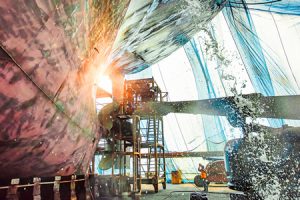[breadcrumb]
 How Can a Shipbuilder Get Mesothelioma by Occupational Exposure to Asbestos?
How Can a Shipbuilder Get Mesothelioma by Occupational Exposure to Asbestos?
Before the dangers of asbestos were well known, asbestos was widely used in ships because it could resist heat and prevent fires that could sink ships. Additionally, it was a good insulator and resistant to corrosion, which makes it ideal for seafaring vessels. Asbestos was included in many components in ships, from the bow to the stern.
Shipbuilders who worked on ships between World War II and the Vietnam War were likely exposed to asbestos. This was asbestos’ peak era, especially in the shipbuilding industry since more vessels were needed for the Navy.
Shipbuilders worked directly with asbestos-containing materials such as insulation, asbestos=laden metal, joint compound and other materials. Asbestos was found on battleships, aircraft carriers, destroyers, cruisers, submarines and auxiliary vessels, so shipbuilders who worked on these vessels could have breathed in asbestos fibers and eventually developed mesothelioma.
Locations in the United States for the Highest Employment Rates for Shipbuilders
According to the United States Bureau of Labor Statistics, there are currently 135,910 people employed in the ship and boat building industry. States with the highest employment rates for ship and boat building workers include:
- California
- Washington
- New York
- Massachusetts
Similar Occupations as Shipbuilders
Similar occupations as shipbuilders include the following:
- Boilermakers
- Carpenters
- Construction laborers and helpers
- Drywall installers and tapers
- Hand laborers and material movers
- HVAC workers
- Insulation workers
- Material moving machine operators
Lawsuits and Settlements Involving Shipbuilders and Mesothelioma
There have been a few notable asbestos cases involving shipbuilders. Since shipbuilders are at a high rate of potential asbestos exposure, there have been many former employees who developed mesothelioma and other asbestos-related diseases due to their occupational exposure. Many of these individuals have filed workers’ compensation claims against the shipyards where they worked and personal injury lawsuits against the makers of asbestos products and boats that they worked on at the shipyards. Several cases have been filed in New York and California by former shipbuilders and shipyard workers. One such case was decided in 2011. A Newport News, Virginia jury awarded $25 million to a former repair supervisor. He helped repair commercial vessels at Newport News Shipbuilding between 1966 and 1977. Before that, he worked at the location as a shipfitter in new construction. The suit was filed against Exxon, which had 17 commercial oil tankers that were being repaired at the shipyard. He was diagnosed with mesothelioma, which was linked to his occupational exposure to asbestos. The jury found that the company was aware of the dangers of asbestos on its ships but took no steps to warn shipyard workers or crew members of these dangers. His award included $12 million in compensatory damages, $430,000 in medical expenses, $12.5 million in punitive damages and interest.
The family of a man who worked at Puget Sound Naval Shipyard for nearly 40 years was awarded $5.2 million when it was found that Foster Wheeler Corp. failed to disclose the risks of removing its asbestos insulation in boilers on many ships.
Studies Related to Shipbuilders and Asbestos
A few studies have explored the risk of asbestos on shipbuilders. The U.S. National Institutes of Health published a study called “Asbestos and Ship-Building: Fatal Consequences” that found shipyard workers were 16 times more likely to die from asbestosis than people in other occupations. Many of these fatalities involved people in the East and West Coast where a lot of shipbuilding was performed.
The Archives of Environmental & Occupational Health reported asbestos-related fatalities in 2017 for people who were employed at the Coast Guard Shipyard in Baltimore from 1950 to 1964. Workers with a moderate level of asbestos exposure were nearly four times more likely to die from mesothelioma than the general population while those with a high level of exposure were more than seven times more likely to die of mesothelioma when compared to the general public.
The number of shipyard workers was reduced after World War II from 1.7 million to 200,000 in the late 1970s.
Studies have shown that military veterans have been particularly affected by asbestos exposure. Approximately 30% of all mesothelioma diagnoses are to military veterans. The Navy is the branch of service that has been most heavily affected.
Types of Asbestos Products Used by Shipbuilders
Asbestos products were prevalent in the construction of ships. They were used in boiler rooms, engine rooms and sleeping quarters. It was used with gaskets and valves. It was widely used as insulation throughout the ship and used to cover pipes. It was also used as an adhesive and mixed with paint.
Asbestos products were also carried on and off ships and found in pallets in shipyards, so shipbuilders could have also been exposed to a variety of other products.
Manufacturers of Products Used by Shipbuilders
Some of the manufacturers of products used by shipbuilders may include:
- GAF Corporation
- Manville Corporation
- Ruberoid Corporation
